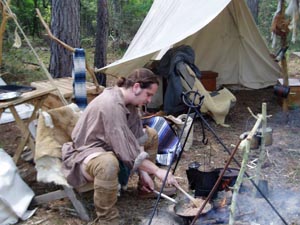 |
|
![]()
|
Home
Getting Started
Further Up The Trail
Resources
Groups
Western Fur Trade
Texas Rev
US Military
In Memoriam
|
Acorns - Prepartion and ReceipesSeems like some are better than others for food. Red oak may be a bit nasty compared to white, or vice-versa. The idea was to crack the acorns, pulverise the meats, and then suspend them in a stream for several days for the water to leach out the bitter tanin. Probably from a Ben Hunt book or some such. We ended up with a paste, never did get it to dry into anything near flour, tried cutting it with a little Bisquick to get it to cling to a stick so we could roast it over coals. It was like eating composted leaves. Bluck! It needed more time in the stream, and was lacking something to bind it together, like shortening or baking soda or whatever Bisquick has that acorns lack. Maybe as a thickening additive for porrage? If I remember right (somewhat rare), the live oak and white oak trees do the best job for us. Try using it as a thickener in game meat stews etc. PaPa did, and he was always right. PREPARATION OF GROUND ACORN MEAL Pick up several cupfuls of acorns. All kinds of oaks have edible acorns. Some have more tannin than others, but leaching will remove the tannin from all of them. Shell the acorns with a nutcracker, a hammer, or a rock. Grind them. If you are in the woods, smash them, a few at a time on a hard boulder with a smaller stone, Indian style. Do this until all the acorns are ground into a crumbly paste. If you are at home, it's faster and easier to use your mom's blender. Put the shelled acorns in the blender, fill it up with water, and grind at high speed for a minute or two. You will get a thick, cream-colored goo. It looks yummy, but tastes terrible. Leach (wash) them. Line a big sieve with a dish towel and pour in the ground acorns. Hold the sieve under a faucet and slowly pour water through, stirring with one hand, for about five minutes. A lot of creamy stuff will come out. This is the tannin. When the water runs clear, stop and taste a little. When the meal is not bitter, you have washed it enough. Or, in camp, tie the meal up in a towel and swish it in several bucketfuls of clean drinking water, until it passes the taste test. Squeeze out as much water as you can, with your hands. Use the ground acorn mash right away, because it turns dark when it is left around. Or store in plastic for freezing if you want to make the pancakes later. ACORN PANCAKES
Break an egg into a bowl. Add: Beak all together. If the batter is too thick to pour, thin it with milk. Pour pancakes into a hot, greased griddle and cook slowly until brown on both sides. Serve with butter and syrup or wild blackberry jam. Delicious!! More on Removing Tanic Acid Acorns have tannic acid in them which is a toxin to mammals. The tannic acidis readily leached out if one prepares the acorn flesh properly. Oaks in the "white oak" family have the least tannin. The species called white oak or "Quercus alba" and Swamp Chestnut oak "Quercus michauxii" are the "sweetest" which means less tannin that the other species. Sawtooth oak, an introduced species, "Quercus accutissima" is also a sweet one. However all true oak acorns can be used. To wit...Grind the acorns into a fine meal or powder. Rinse in cool water until the meal no longer has the bitter taste. Dry the meal/flower and use as a meal/flower. The natives made a primitive bread from the flower. There is not much taste to the finished product but you could add some honey locust pods and it would be very sweet treat. Disclaimer: Don't eat the tannic acid. However, I do not think your tongue will let you get the bitter taste very far The California Academy of Sciences use to have a video display of a woman preparing acorn. Ground it the old fashion way with stone mortar & pestal. Then she placed the powder into a bag which she deposited in a creek to allow the running water to leach out the tannic acid. The acorn meal was then placed into a watertight basket with water. She then heated a rock and placed the rock into the basket. A looped stick was used to move the rock so it wouldn't burn its way through the basket and to stir the acorn & water mixture. The heat from the rock cooked the mixture until it became a gruel. Dinner is served.
|
![]()



